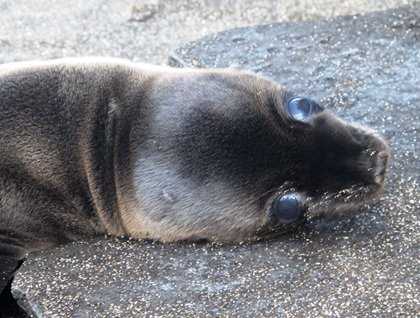Also known as James Island, the island of Santiago lies in the heart of the Galapagos archipelago. Its outline is marked by various peaks, remnants of old volcanic craters. During the late 1600s and early 1700s, Santiago used to be visited by privateers and buccaneers of various nationalities. Here they could find safe anchorages, abundant giant tortoises to eat as well as semi-permanent fresh water springs from which they could quench their thirst. Local folklore says that they may have left some treasure hidden somewhere in the island, and never returned back to find it. Nowadays, the island does contain invaluable treasures in the various endemic species that inhabit it in total peace. Early in the morning we set foot on Espumilla Beach, a beautiful beach lined by a row of robust mangroves. A trail led us further inland and we reached a crest from which we could enjoy the view of the beautiful coastline and our ship anchored not far. All along we were accompanied by curious land birds like juvenile Galapagos flycatchers, tree and ground finches and endemic mockingbirds. We maximized our time this morning and a little later, after a short navigation towards Buccaneer Cove, we had more adventures to enjoy. Some opted to explore the gorgeous coastline by kayak, an activity that allowed our guests to enjoy the scenery in total peace. Others preferred to take an outing on the glass-bottom boat, where they could observe various fish species underwater. Later in the morning many returned to the area to snorkel, and were able to successfully swim with white-tipped reef sharks and large schools of fish.
In the afternoon, we moved once more and dropped anchor further south along the coast. This time we were to visit Puerto Egas, off James Bay. A former settlement, this black beach remains inhabited by wildlife and is surrounded by wonderful tuff rock formations. The coastline is full of wildlife, and not long after setting foot ashore we encountered abundant marine iguanas and Galapagos sea lions. The stunning Sally lightfoot crabs add color to this dark coastline. They make the best contrast with their red and orange colors over the black lavas. Many snorkelers enjoyed a fantastic time shared with the playful sea lions that inhabit Puerto Egas, while our walkers had a chance to explore the bizarre coastline of the area, with its many tuff formations and lava flows. At the far end, some natural pools known as the ‘grottos’ are the home to a small colony of Galapagos fur sea lions. The warm afternoon light bathed everything with its yellow light, and it was time to return back to our ship, but we are sure that the memories of this magical place will remain forever in our minds.







